Introduction
In the graceful dance of nature and culture, the Japanese crane, or tsuru, stands tall as an elegant symbol that has long captivated artists and audiences alike. These ethereal birds, native to Japan and parts of East Asia, embody concepts that transcend their physical beauty. In the visual language of ukiyo-e art, the tsuru emerges as a powerful motif, symbolizing longevity, fidelity, and fortune. Exploring the depictions of Japanese cranes in ukiyo-e and other Japanese art forms reveals the deeply rooted cultural significance of these majestic creatures.
The Symbolism of the Japanese Crane
The Japanese crane, also known as the red-crowned crane (Grus japonensis), holds profound symbolic weight in Japanese culture. Often referred to as the “bird of happiness,” the crane embodies auspicious qualities like good fortune and harmony. In legend, cranes live for a thousand years, linking them to the virtues of immortality and long life. Their life-long monogamous bonds represent loyalty and fidelity, making them popular symbols at weddings and celebrations.
In traditional Japanese folklore, cranes are considered divine intermediaries between the earthly realm and the gods. They appear as graceful beings that transcend the mundane, effortlessly soaring above the world while guiding human prayers to celestial ears. This ethereal quality contributes to their prevalence in various art forms, particularly ukiyo-e woodblock prints.
Depictions in Ukiyo-e Art
Ukiyo-e, a genre that flourished during Japan’s Edo period (1603-1868), beautifully captured the spirit of tsuru through intricate woodblock prints. As the genre evolved, artists began exploring natural landscapes and fauna with greater sophistication, finding the crane to be a compelling muse. Their depiction in ukiyo-e was often imbued with layers of meaning, alluding to seasonal changes, spiritual realms, or societal ideals.
Notable Examples of Japanese Cranes in Ukiyo-e Art
Here are notable examples of depictions of the Japanese crane in ukiyo-e art especially by the masters Hokusai and Hiroshige.
Umezawa Manor in Sagami Province by Katsushika Hokusai, 1832
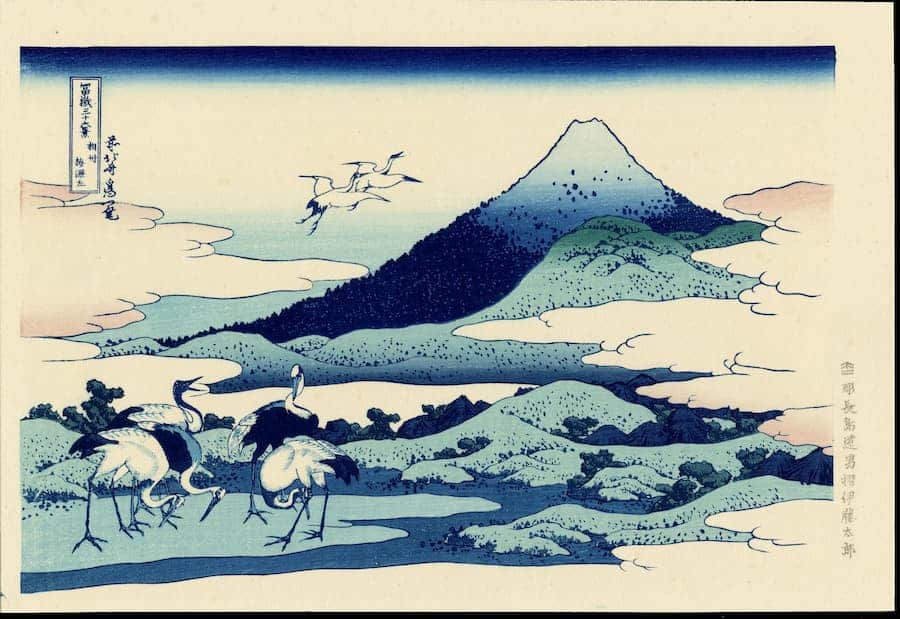
In Umezawa Manor in Sagami Province, from the series Thirty-six Views of Mount Fuji, Hokusai depicts a tranquil and idyllic landscape unfolds under a wide sky. The composition features a majestic Mount Fuji in the background, its peak rising sharply against a clear sky. In the foreground, several cranes gather gracefully by a winding stream. This artwork skillfully blends the serene beauty of the natural world with the cultural reverence for cranes and Mount Fuji, inviting viewers to ponder the harmonious coexistence of nature and symbolism. Hokusai’s use of delicate color gradients and detailed line work enhances the peaceful yet dynamic atmosphere of the scene, making it a captivating example of his mastery in landscape ukiyo-e.
Cranes on Snow-Covered Pine by Katsushika Hokusai, 1834
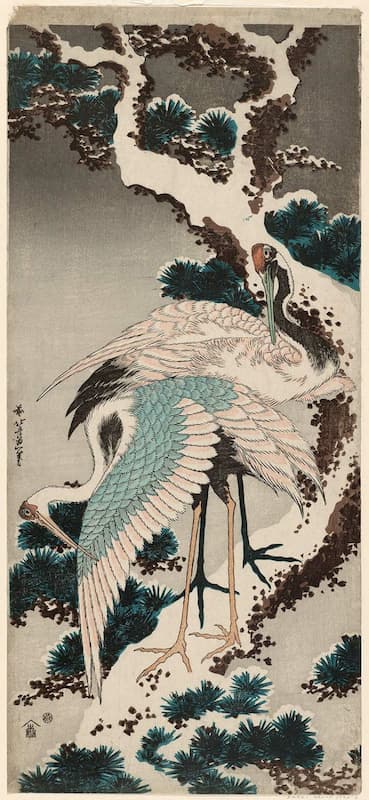
Hokusai’s skill in rendering intricate natural scenes is showcased in Cranes on Snow-Covered Pine. Here, cranes stand elegantly atop snow-dusted pine branches, exemplifying their association with winter landscapes. The birds’ striking red crowns against the cool, muted background emphasize their striking presence and reinforce the seasonal motif.
Cranes on the Seashore by Ohara Koson, 1933
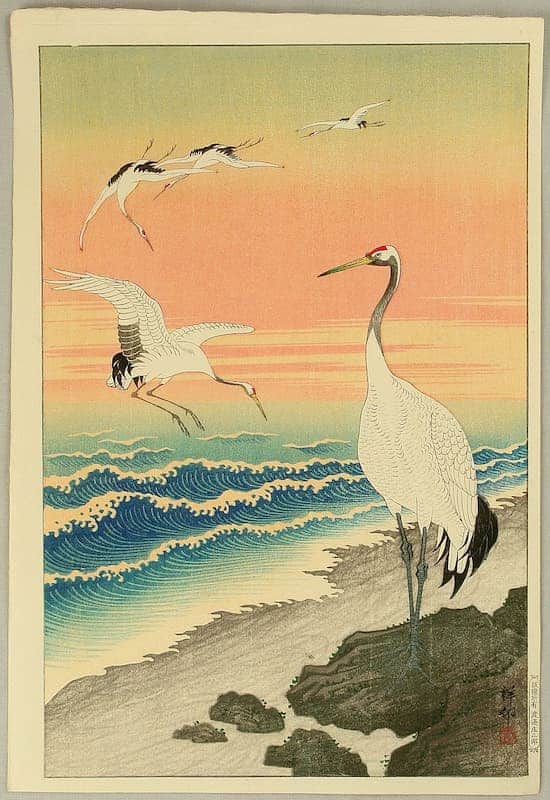
This striking woodblock print by Ohara Koson depicts Japanese cranes along the seashore, set against a vibrant sunset. Ohara Koson was a renowned artist specializing in kacho-e, prints featuring birds and flowers, within the shin-hanga style of the early 20th century. Here, the cranes stand elegantly against the swirling blue waves, reflecting their revered status in Japanese culture. The composition masterfully balances the dynamic movement of the sea with the tranquil poise of the cranes. And it showcases Koson’s skill in capturing both the beauty of nature and the cultural significance of these majestic birds.
Cranes Flying Over Waves, Utagawa Hiroshige
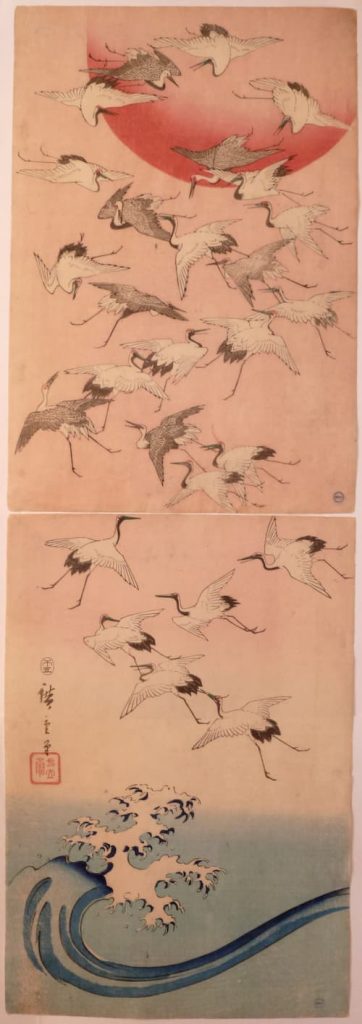
In a classic example from ukiyo-e master Utagawa Hiroshige, Cranes Flying Over Waves showcases cranes flying gracefully against a crisp blue sky. This image exemplifies the idea of freedom and transcendence associated with these birds. Their streamlined forms and fluid movements evoke themes of travel, transition, and spiritual ascent.
Shown above is a rare diptych set of two prints.
Minowa, Kanasugi, Mikawashima, No. 102 by Utagawa Hiroshige
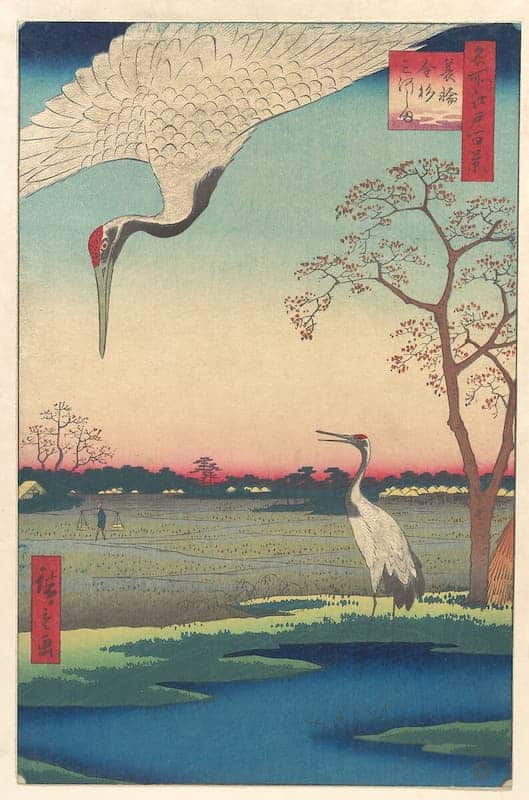
This evocative woodblock print by Utagawa Hiroshige, is from his renowned series “One Hundred Famous Views of Edo.” The title Minowa, Kanasugi, Mikawashima refers to the three villages in the vicinity of this view. Specifially, Mikawashima was the location of the annual Shogun Crane Hunt (see details below) during the winter.
In the artwork, a large crane soars gracefully above a serene landscape, its wings finely detailed, contrasting with the soft, muted colors of the dawn or dusk sky. Below, another crane stands near the water’s edge, amid a tranquil field bordered by sparse trees and a distant figure carrying rice. Hiroshige masterfully captures the quietude of the scene, using the cranes as focal points that draw the viewer into a moment of peaceful contemplation. The print is a beautiful example of Hiroshige’s ability to blend natural beauty with cultural symbolism, reflecting the harmony between humans and nature.
The Shogun’s Crane Hunt
Every winter, during the crane migration to Japan, the shogun hosted the annual Crane Hunt at Mikawashima. This event celebrated the crane and was a key part of a broader cultural tradition. These hunts were not just ceremonial but also held deep ritualistic significance, embodying the crane’s revered status in Japanese culture.
Furthermore, the shogun, leading a large group of 70 – 80 people, would often start the hunt by releasing the first hawk. The captured cranes, highly esteemed, were frequently gifted to the emperor in Kyoto as symbols of prestige. Although the hunts aimed to capture only a few cranes for ceremonial reasons, they underscored the bird’s esteemed role in Japanese tradition and art.
Despite the hunting, cranes received protection and care, showcasing a complex interplay of exploitation and reverence. This contradiction appears in Utagawa Hiroshige’s art, which portrays cranes in peaceful natural settings and a caretaker in the background. His works not only highlight the birds’ elegance and beauty but also their significant place in Japanese cultural and artistic life.
Japanese Cranes in Other Forms of Art
Beyond ukiyo-e, Japanese cranes feature prominently in other art forms, from ceramics and textiles to ink paintings and poetry. In the tea ceremony, tsuru imagery is often found on teaware, suggesting auspiciousness for those partaking in the ritual. Kimono designs feature elegant crane motifs, sometimes paired with pines or plum blossoms, further symbolizing prosperity and harmony.
Ink paintings from the kacho-ga tradition (bird-and-flower painting) often feature cranes. Artists like Maruyama Okyo depicted the bird in various natural settings, capturing their graceful movements with deft brushstrokes. Okyo’s paintings, like this one entitled Cranes on the Japanese screen (Byōbu) emphasize simplicity and elegance, blending realistic forms with the symbolic importance of the tsuru.
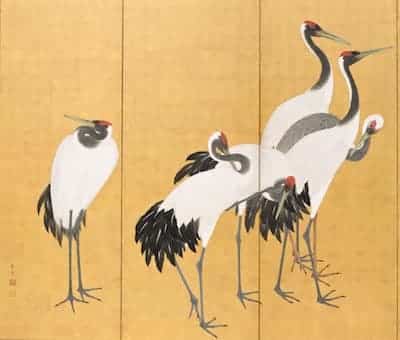
Poetry, too, lauds the beauty and significance of cranes. Haiku poets capture fleeting moments of cranes flying through the mist or gathering in a distant field, immortalizing their movements in brief verses that convey a sense of harmony and timelessness.
Conclusion: Japanese Cranes in Ukiyo-e Art
The Japanese crane, in its sweeping elegance and rich symbolism, remains a cherished icon in Japanese art. In ukiyo-e, its depiction offers a window into the spiritual ideals and aesthetic values of the Edo period. Whether standing serenely on snow-covered pines or flying freely above Edo’s waterways, the tsuru continues to embody qualities that have resonated across centuries—longevity, fidelity, and the promise of happiness. Each work of art reflects a culture’s enduring reverence for this divine bird, underscoring the crane’s role as a graceful guide between the temporal and the eternal.
Read more:
- 11 Things to Know About Collecting Japanese Woodblock Art
- 11 Most Influential Ukiyo-e Artists: Masters of Japanese Woodblock Prints
- The Enchanting Symbols of Japanese Art
- The Tale of Genji and Its Representation in Ukiyo-e Art
- The Art of Kamon: Discovering Japan’s Timeless Family Crests
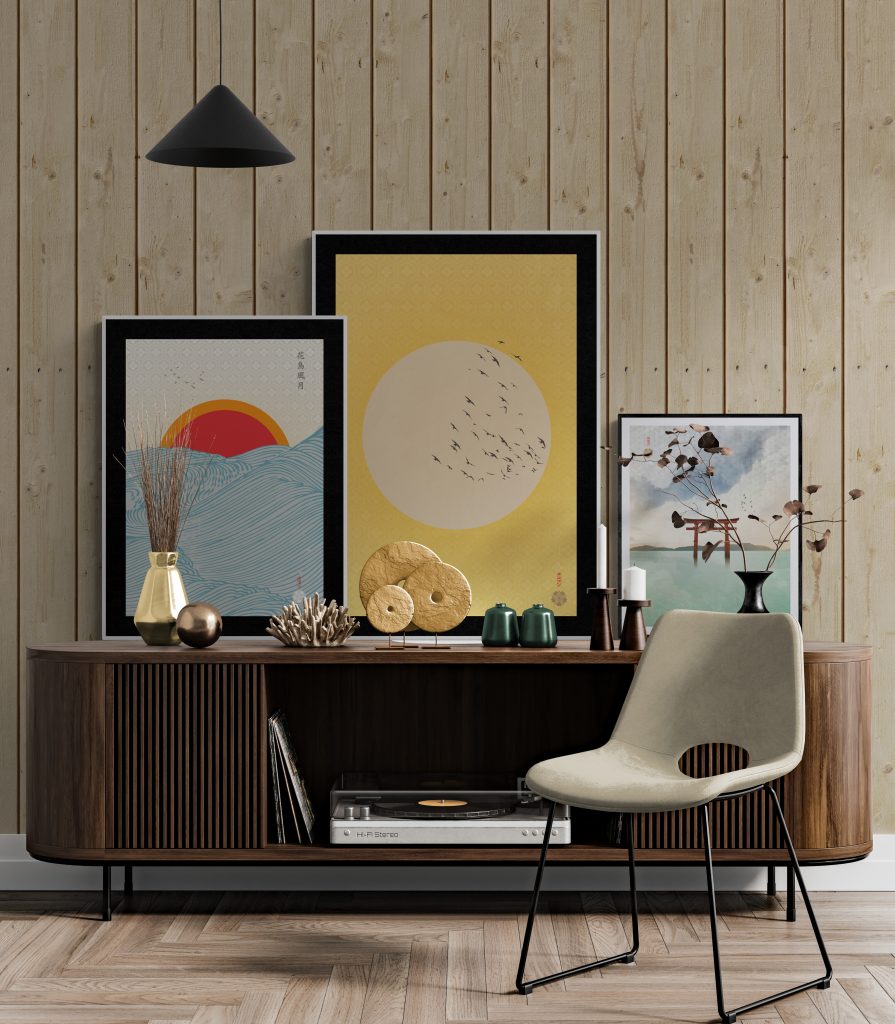
At the Art of Zen we have a selection of original Japanese art prints in the ukiyo-e and Japandi style. Some of our best selling work is Mount Fuji wall art and Japandi wall art.
Add some zen to your space with brilliant original art from the Art of Zen shop.
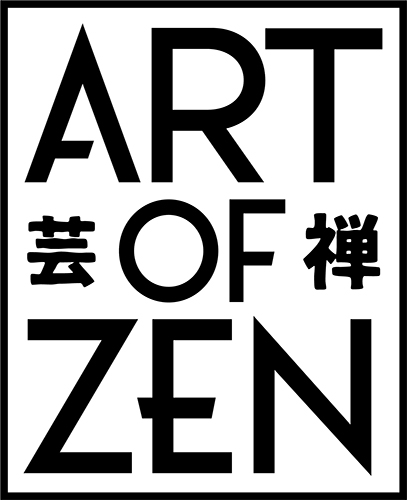
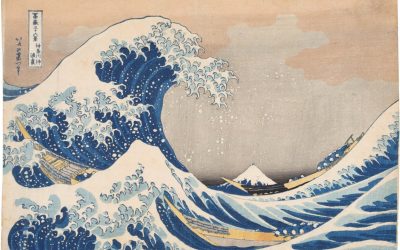
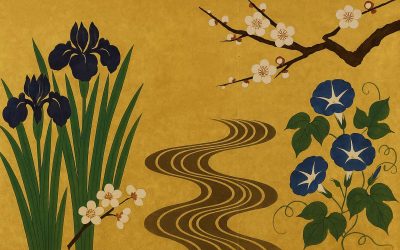

0 Comments